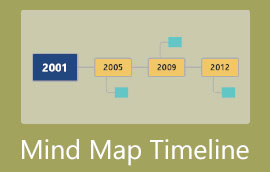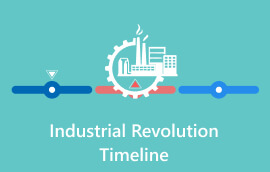Come to Know the Timeline of the Great Depression
The Great Depression was one of the most famous economic downturns in history. It also is the longest recession that has affected many countries worldwide. Most of us know this term and might be curious about what happened then. If you want to satisfy your curiosity, you are on the right post to read. Get to know the timeline of the great depression's history as we discussed everything. Also, learn how to make a timeline using reliable software. Without delay, let’s continue.

- Part 1. Introduction to the Great Depression
- Part 2. Great Depression Timeline
- Part 3. Great Depression Major Events
- Part 4. FAQs About Great Depression Timeline
Part 1. Introduction to the Great Depression
The Great Depression was an economic shock during the 1930s. It also stands as one of the most significant periods in modern history. The Great Depression crisis left a memorable mark on economies, societies, and individuals. It also reshaped the global landscape and influenced economic and social policies today.
The beginning of it can be traced back to when the world was recovering from the aftermath of the First World War. The combination of the stock market crash, unemployment, and a collapse of international trade created the crisis. Although this happened in the United States, it affected almost all countries worldwide. Thus, not only Americans experienced the hardships but the rest of the world. The Great Depression kicked off when the stock market crashed in October 1929. To elaborate on what happened next, move on to the Great Depression timeline part.
Part 2. Great Depression Timeline
Here’s a timeline of the Great Depression timeline from 1929 to 1939. Check out its visual presentation to understand it better.

Get a detailed Great Depression timeline.
Bonus Tip: How to Create a Timeline with MindOnMap
When you need a timeline maker, MindOnMap can serve as your go-to solution. MindOnMap is an online-based timeline diagram creator that you can access on various browsers. Now, it also has a downloadable app for computers. The tool lets you create a diagram such as an organizational chart, fishbone, treemap, flow chart, and more. With it, you can also integrate photos and links as you wish. Furthermore, it has an auto-saving feature. It allows you to save whatever you’re working on after a few seconds of not using the tool. Aside from that, you are allowed to save your work in your desired file format. To know how MindOnMap creates a timeline of Great Depression history, follow the guide below.
Firstly, access the MindOnMap by going to its official website. Then, you can choose from Free Download or Create Online on the tool's main interface. And create an account.
Secure Download
Secure Download
Afterward, you’ll see various templates which you can choose from. Select the Flowchart option since it’s the most suitable to create a timeline.

Now, start editing your timeline. Add the shapes, lines, color fills, texts, etc., you want for your timeline.

Alternatively, if you want to collaborate with your friends or workmates, you may click the Share button and copy the link to your work. You can also set the Valid Date and Password as you wish.

Once you’re satisfied with your timeline, you may now save it. Click the Export button at the top-right-hand part of the tool’s interface. Then, select your desired output format. Wait for a few seconds, and that’s it!

Part 3. Great Depression Major Events
In this part, we have explained what happened in the Great Depression timeline. There are also some major events you need to note. These are the following:
The Wall Street Crash Sparks the Depression (1929)
The Great Depression began when the U.S. stock market plummeted. Thus wiping out great fortunes and causing panic among investors.
The Dust Bowls Begin (1930)
In the 1930s, the Dust Bowl began. A period of severe dust storms and droughts affected the Southern Plains of the U.S.
Food Riots and Banks Collapse (1931)
As the Great Depression deepened, food riots and bank failures also increased. It reflected the desperation of the Americans who lost their jobs and savings.
President Roosevelt is Elected (1932)
Franklin D. Roosevelt was elected the President of the United States. Then, he promised a “New Deal” to address his plans for economic recovery.
The First Hundred Days and The New Deal (1933)
Within the first one hundred days of Roosevelt’s administration, they implemented 15 laws, also known as his “New Deal”. It aimed to tackle and provide relief to the Great Depression.
Dust Storms and Droughts Continue (1934)
The Dust Bowl continued, and the worst dust storms hit the United States. Americans also experienced the hottest temperature record in 1934.
Creation of the Works Progress Administration (1935)
The Works Progress Administration was made in 1935 to employ millions of unemployed Americans. Also, to help the farmers, they implemented the Rural Electrification Act.
President Roosevelt Elected For a Second Term (1936)
Roosevelt was elected as the president of the U.S. again in 1936. It is a testament to the popularity of his New Deal programs. Yet, the heat in the U.S. continues to be ablaze.
Spending on New Deal Programs Cut (1937)
In 1937, Roosevelt had a hard time managing the debt. So, he reduced spending on his New Deal programs, which led the economy back into the depression.
Economic Growth (1938)
Despite the setbacks, the U.S. economy started to grow in 1938. Eventually, the U.S. experienced a gradual recovery from the Great Depression. Yet, unemployment rates are still high.
The Start of World War Two (1939)
There was a shift in the economy of the U.S. when World War II started. The industries began to grow, provided jobs, and stimulated economic activity.
Defense Budget Increased (1940)
President Roosevelt raised the defense budget and top income tax rate to 81% during the war.
United States Enters the War (1941)
The United States exited the Great Depression by entering the war after the Japanese attack on Pearl Harbor. Despite the devastation after the war, the U.S. became the world's sole economic superpower.
Further Reading
Part 4. FAQs About Great Depression Timeline
What 5 events led to the Great Depression in chronological order?
The Great Depression is attributed to 5 various factors. It includes the stock market crash, the Smoot-Hawley Tariff, government policies, bank failures, and the money supply collapse.
What year was the worst during the Great Depression?
The worst year/s happened after 1929, which started in December 1930. It is also where crises hit panic levels again.
What happened in 1931 that shows the depression was getting worse?
It was when food riots and bank failures became increasingly common in 1931. Thus, many Americans have become desperate since they lost their jobs.
Conclusion
To summarize, now you know what happened in the Great Depression timeline. As shown above, a visual presentation makes it easier to understand the timeline. An appropriate tool will also help you make a timeline according to your needs. So, the top example is MindOnMap. Using its easy-to-understand interface, you can create a personalized timeline or any diagram. Last but not least, it is suitable for first-timers and professionals.










